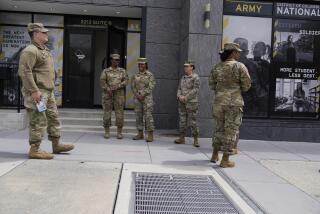Pentagon Plan to Modernize Calls for Troop, Base Cuts
- Share via
WASHINGTON — In its biggest strategic review since the Cold War’s close, the Pentagon called Monday for new rounds of military base closing and elimination of 225,000 active duty, reserve and civilian support jobs to free funds for new weapons and troop readiness.
Despite expected fierce opposition from Congress, the long-awaited report said that only with new base cuts will the U.S. military be able to afford a superpower’s obligations to keep forces based near danger spots around the world while performing costly peace-keeping operations and other missions.
“We must shed more weight,” Secretary of Defense William S. Cohen, who has called for new rounds of base closings in 1999 and 2001, said in introducing the report. “If you want to keep the bases, then you will not modernize.”
The report, six months in preparation, had been expected by some experts to make difficult choices between buying new weapons and maintaining a large force structure. When the work was completed, however, officials decided that the Pentagon needed almost all the new weapons and almost all the troops--and looked to politically unpalatable base closings to pay for them.
The new strategic recipe is already provoking an outcry in California, which still has nearly 100 military facilities, large and small, despite the deep cuts of recent years.
The report’s emphasis on paring weapons development labs, of which California has several, is likely to breed further unhappiness in the state.
The Pentagon’s massive infrastructure--test ranges, weapons labs and military training centers strung across tens of thousands of square miles of the western United States--is a ripe target for Pentagon cutbacks. The General Accounting Office last year estimated that the Pentagon has 35% too much capacity in its labs and test ranges.
California has a wealth of such bases, including the China Lake Naval Weapons Center, Edwards Air Force Base and the Naval Air Warfare Center at Point Mugu.
The research centers are economically important, employing thousands of civilians and providing important links to high technology industry around the state.
The looming cutbacks could become a battle of East versus West, pitting research centers in Maryland and Florida against California and the rest of the Southwest, said Frank Knemeyer, a retired deputy technical director from China Lake in Ridgecrest.
As a result, groups across Utah, Nevada, Arizona, New Mexico and California are forming a political alliance to protect research labs and training centers, Knemeyer said. The group, known as the Southwest Defense Alliance, recently met in Washington with members of Congress.
While acknowledging that base closings would be “unpleasant,” Cohen signaled that he intends to campaign hard for them, pointing out to Congress that there can be no new weapons without them.
If members of Congress ask pointed questions about the absence of weapons spending, he said, he would tell them that the money is tied up in warehouses, depots and other now-unnecessary property. And he said that beginning today he will tell Congress about “success stories” of base closings that have proved an economic boon for their communities.
The report’s call for relatively modest personnel cuts represents a victory for the military leadership’s view that the Pentagon cannot shave a lot of functions or planned weapons without shouldering major new risks.
The makeup of the job cuts also reflects the Pentagon’s targeting of infrastructure-related positions. Such support jobs account for almost half the cuts, and civilians hold 80,000 of those 109,000 positions. Of the remainder, 61,800 cuts will come from active-duty troops and 55,000 from the reserves.
The report follows in the pattern of earlier strategic reviews that have settled for incremental rather than sweeping change.
Cohen begins the report by striking back at reformers who already have denounced it as a cautious document that does not do enough to reshape a military still designed to deal with the Cold War.
In introducing the report to reporters, Cohen said that he was “not seeking to be bold but to devise the best system.”
The report points out that the U.S. military already has shrunk substantially from Cold War days when it was supported by a $400-billion (inflation-adjusted) budget and a 2.1-million-troop active duty force. Today the active-duty head count is 1.44 million and the $250-billion budget is expected to remain flat for several years at least.
The new review also calls for:
* Reductions in active-duty forces of 15,000 from the Army, 18,000 from the Navy, 27,000 from the Air Force and 1,800 from the Marines. That, coupled with previously planning reductions, would bring the active-duty force to 1.36 million by 2003, down from 2.1 million in 1989.
* Cutting the number of the Navy’s surface combat ships from 128 to 116, although it will keep 12 aircraft carriers and 12 battle groups. The Air Force cuts would be made in large part by paring the numbers of tactical aircraft used in continental air defense.
* Paring expensive new tactical aircraft development programs, but not abandoning any of them--a substantial victory for defense contractors. The Air Force plans to buy 339 F-22s, down from 438. The Navy plans to get 548 F-18 E/F fighters, down from 1,000.
* Maintenance of about 100,000 troops in Asia and another 100,000 in Europe.
Cohen predicted that the report’s proposals to cut the National Guard and reserves “will be an area of great controversy.”
Times staff writer Ralph Vartabedian contributed to this story.
(BEGIN TEXT OF INFOBOX / INFOGRAPHIC)
Key Points (Southland Edition, A1)
The Pentagon proposal, which must undergo several steps before approval, would:
* Close more bases (an additional two rounds).
* Cut backup forces.
* Scale back weapons purchases.
****
Tracking Troop Cutbacks
Number of active-duty military personnel:
Current: 1.44 million
Source: Defense Department
Researched by D’JAMILA SALEM-FITZGERALD / Los Angeles Times
(BEGIN TEXT OF INFOBOX / INFOGRAPHIC)
Impact on Troops and Weapons
The Pentagon says the proposed cutbacks would leave enough forces to win two regional wars almost simultaneously. Most of the cuts would come from thinning support systems and two more rounds of base closures.
Troop Strength
*--*
Proposed cut # remaining Active force 90,000 1.36 million Reserves 65,000 835,000 Civilian workers 109,000 640,000
*--*
****
Weapons
* Reduce the total buy of Air Force F-22 fighters from 438 to 339 aircraft.
* Cut the Navy FA-18 E/F fighter program nearly in half, to 548 planes down from a planned 1,000.
* Move up initial production of the multi-service Joint Strike Fighter to 2008 and build a total of 2,852 planes, a reduction of 126.
* Speed up development of the Marine Corps V-22 Osprey tilt-rotor aircraft.
More to Read
Sign up for Essential California
The most important California stories and recommendations in your inbox every morning.
You may occasionally receive promotional content from the Los Angeles Times.











